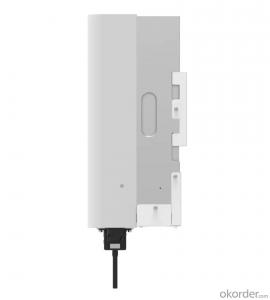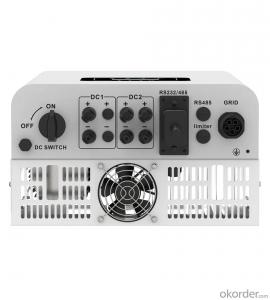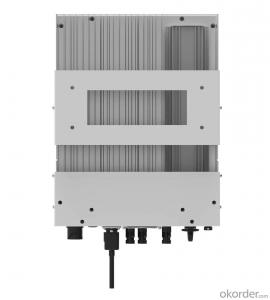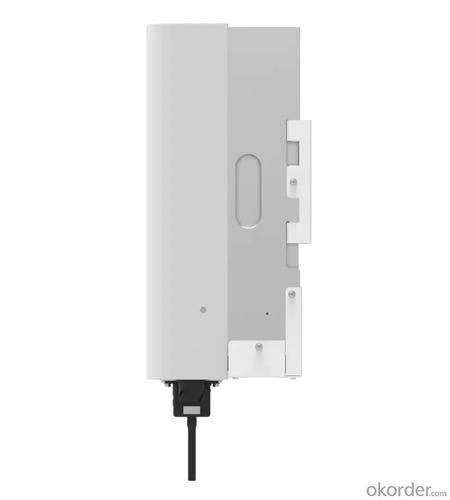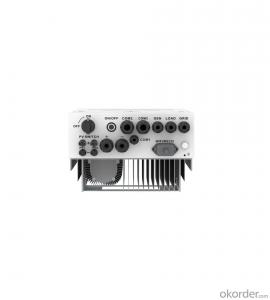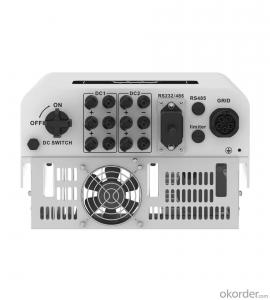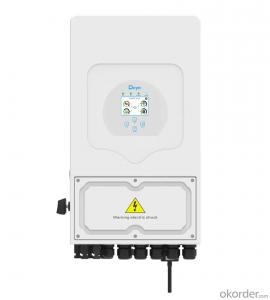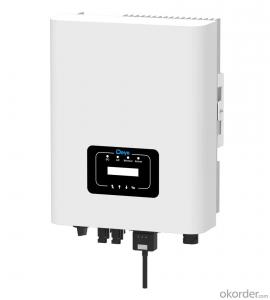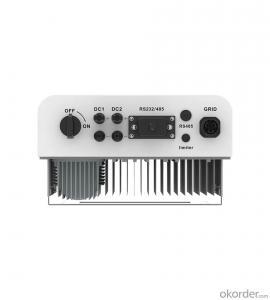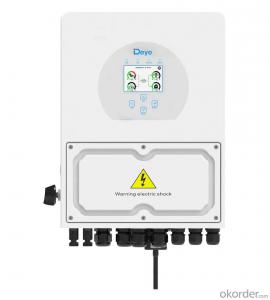Su Kam Solar Inverter - Sun-6/8k-g03-lv | 6-8kW | Three Phase | 2 MPPT | Low Voltage | 127/220VAC
- Loading Port:
- Ningbo
- Payment Terms:
- TT OR LC
- Min Order Qty:
- 100 pc
- Supply Capability:
- 5000 pc/month
OKorder Service Pledge
OKorder Financial Service
You Might Also Like
Specification
| Technical Data | ||||
| Model | SUN-6K-G03-LV | SUN-8K-G03-LV | ||
| Input Side | ||||
| Max. DC Input Power (kW) | 7.8 | 10.4 | ||
| Max. DC Input Voltage (V) | 800 | |||
| Start-up DC Input Voltage (V) | 250 | |||
| MPPT Operating Range (V) | 200~700 | |||
| Max. DC Input Current (A) | 13+13 | 13+26 | ||
| Max. Short Circuit Current (A) | 19.5+19.5 | 19.5+39 | ||
| Number of MPPT / Strings per MPPT | 2/1 | 2/1+2 | ||
| Output Side | ||||
| Rated Output Power (kW) | 6 | 8 | ||
| Max. Active Power (kW) | 6.6 | 8.8 | ||
| Nominal Output Voltage / Range (V) | 3L/N/PE 127/0.85Un-1.1Un,220 /0.85Un-1.1Un (this may vary with grid standards) | |||
| Rated Grid Frequency (Hz) | 60 / 50 (Optional) | |||
| Operating Phase | Three phase | |||
| Rated AC Grid Output Current (A) | 15.7 | 21 | ||
| Max. AC Output Current (A) | 17.3 | 23.1 | ||
| Output Power Factor | 0.8 leading to 0.8 lagging | |||
| Grid Current THD | <3%< span=""> | |||
| DC Injection Current (mA) | <0.5%< span=""> | |||
| Grid Frequency Range | 57~62 | |||
| Efficiency | ||||
| Max. Efficiency | 98.3% | 98.5% | ||
| Euro Efficiency | 97.5% | |||
| MPPT Efficiency | >99% | |||
| Protection | ||||
| DC Reverse-Polarity Protection | Yes | |||
| AC Short Circuit Protection | Yes | |||
| AC Output Overcurrent Protection | Yes | |||
| Output Overvoltage Protection | Yes | |||
| Insulation Resistance Protection | Yes | |||
| Ground Fault Monitoring | Yes | |||
| Anti-islanding Protection | Yes | |||
| Temperature Protection | Yes | |||
| Integrated DC Switch | Yes | |||
| Remote software upload | Yes | |||
| Remote change of operating parameters | Yes | |||
| Surge protection | DC Type II / AC Type II | |||
| General Data | ||||
| Size (mm) | 330W×457H×205D | 333W×472H×202D | ||
| Weight (kg) | 11 | 15 | ||
| Topology | Transformerless | |||
| Internal Consumption | <1W (Night) | |||
| Running Temperature | -25~65℃, >45℃ derating | |||
| Ingress Protection | IP65 | |||
| Noise Emission (Typical) | <25 dB | <40 dB | ||
| Cooling Concept | Natural cooling | Smart cooling | ||
| Max. Operating Altitude Without Derating | 2000m | |||
| Warranty | 5 years | |||
| Grid Connection Standard | CEI 0-21, VDE-AR-N 4105, NRS 097, IEC 62116, IEC 61727, G99, G98, VDE 0126-1-1, RD 1699, C10-11 | |||
| Operating Surroundings Humidity | 0-100% | |||
| Safety EMC / Standard | IEC/EN 61000-6-1/2/3/4, IEC/EN 62109-1, IEC/EN 62109-2 | |||
| Features | ||||
| DC Connection | MC-4 mateable | |||
| AC Connection | IP65 rated plug | |||
| Display | LCD160 | |||
| Interface | 2 RS485/RS232/Wifi/LAN | |||
127/220Vac and 60Hz, three phase system
2 MPP tracker, Max. efficiency up to 98.5%
Zero export application, VSG application
String intelligent monitoring (optional)
Wide output voltage range
Anti-PID function (Optional)
This series inverter is specially designed for 127/220Vac three-phase system, especially suits for South American areas. With compactness design, easy to install and operate. It supports wide AC output voltage to ensure longer working hour, improving your economic benefits.
- Q: Can a solar inverter be used with a generator?
- Yes, a solar inverter can be used with a generator. In fact, using a solar inverter in conjunction with a generator can provide a more reliable and efficient power supply. The solar inverter can convert the DC power generated by the solar panels into AC power, which can then be used to power various appliances and devices. When the solar panels are not producing enough electricity, the generator can kick in to provide additional power, ensuring a continuous and stable energy supply.
- Q: What is the role of a bypass switch in a solar inverter?
- The role of a bypass switch in a solar inverter is to provide a means for redirecting the flow of electricity in case of an emergency or failure within the inverter. It allows for the direct connection of the solar panels to the utility grid, bypassing the inverter, ensuring a continuous supply of electricity even when the inverter is not functioning properly. This helps maintain the stability and reliability of the solar power system.
- Q: Can a solar inverter be used in areas with high levels of electrical noise or interference?
- In areas with high levels of electrical noise or interference, a solar inverter can indeed be utilized. However, it is crucial to verify that the solar inverter is specifically designed and equipped to handle such conditions. Some contemporary solar inverters come with built-in features and technologies that aid in minimizing electrical noise and interference. These features encompass advanced filtering, shielding, and surge protection mechanisms. In addition, employing proper grounding and installation techniques can further diminish the impact of electrical noise and interference on the solar inverter's performance. To ensure compatibility and optimal performance in high-noise environments, it is recommended to seek advice from a professional or the manufacturer of the solar inverter.
- Q: How does a solar inverter handle voltage phase imbalance in the grid?
- A solar inverter handles voltage phase imbalance in the grid by monitoring the phase angles of the grid voltage and adjusting its output accordingly. It continuously measures the phase imbalance and corrects it by injecting reactive power into the grid. This helps to balance the voltage across the different phases and maintain stable grid conditions.
- Q: Can a solar inverter be used in harsh weather conditions?
- Yes, solar inverters can be designed and built to withstand harsh weather conditions. Many modern solar inverters are equipped with protective features such as dust and moisture resistance, temperature tolerance, and surge protection. These features make them suitable for operating in extreme temperatures, high humidity, dusty environments, and even during heavy rain or snow. However, it is important to ensure that the chosen inverter is specifically designed for the intended weather conditions to ensure its durability and performance.
- Q: What is the role of voltage regulation in a solar inverter?
- The role of voltage regulation in a solar inverter is to ensure that the output voltage of the inverter remains stable and within a certain range, regardless of fluctuations in the input voltage from the solar panels. This is important as it allows the inverter to effectively convert the DC power generated by the solar panels into AC power that can be used by household appliances or fed back into the grid. Voltage regulation helps protect the connected devices from voltage spikes or drops, optimizes the performance of the inverter, and ensures the safe and efficient operation of the entire solar power system.
- Q: Can a solar inverter be connected to a backup battery system?
- Yes, a solar inverter can be connected to a backup battery system. This allows the excess solar energy generated during the day to be stored in the backup battery system for later use during times when there is no sunlight available, such as at night or during power outages.
- Q: Can a solar inverter be used in a community solar project?
- Yes, a solar inverter can be used in a community solar project. In fact, a solar inverter is an essential component of any solar power system, including community solar projects. It converts the direct current (DC) electricity generated by the solar panels into alternating current (AC) electricity that can be used to power homes and businesses in the community. The solar inverter also helps regulate the flow of electricity and ensures the system operates efficiently.
- Q: What is the maximum DC input current that a solar inverter can handle?
- The maximum DC input current that a solar inverter can handle varies depending on the specific model and capacity of the inverter. It is typically mentioned in the product specifications and can range from a few amps to several hundred amps.
- Q: What are the common fault indications in a solar inverter?
- Common fault indications in a solar inverter can include error messages on the display panel, blinking lights, sudden shutdowns or restarts, abnormal noise, overheating, and fluctuations in power output.
Send your message to us
Su Kam Solar Inverter - Sun-6/8k-g03-lv | 6-8kW | Three Phase | 2 MPPT | Low Voltage | 127/220VAC
- Loading Port:
- Ningbo
- Payment Terms:
- TT OR LC
- Min Order Qty:
- 100 pc
- Supply Capability:
- 5000 pc/month
OKorder Service Pledge
OKorder Financial Service
Similar products
Hot products
Hot Searches
Related keywords
